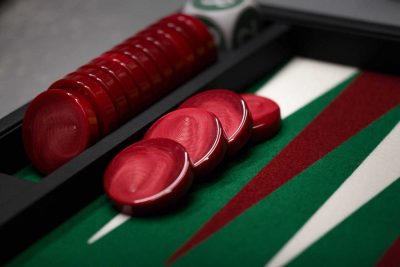by Mary Hickey
Reprinted with permission from GammonVillage, December 18, 2010
This invitation is directed to the “social players” on all the backgammon playing sites where there are large numbers of regulars who have never played in a live tournament. When I talk with online players about making the move to live play, I am always surprised to hear that many of them have never played on a real board! What is keeping them home at their screens when they could be enjoying this game out in the real world, too?
For this article, I asked some real, live social players online why they have never attended a live backgammon event. If this is you, why not make a New Year’s resolution to give a tourney a try this year or maybe next? The following points are intended as a FAQ to answer some of the most common questions and fears regarding live play. Here are some answers that I hope will help you make the leap.
Your el-cheapo Wal-Mart backgammon board is good enough to get you started.
Sure, when you first walk in to the playing room at a tournament, you will see people playing on large, beautiful boards handcrafted from fine woods, with big marbleized checkers and smooth-textured playing surfaces. These boards cost hundreds of dollars, and nobody expects a new player to spend that kind of dinero for basic playing equipment. The only thing you will need to buy is two pairs of precision dice, and possibly dice cups with lips so the dice cannot slide out without tumbling a bit. Ask the director if precision dice will be available for purchase at their event – they often are. [Editorial Note: You can buy beautiful precision dice at the GammonVillage store. We also carry dice cups and backgammon sets at all price levels.]
If you don’t have a “real” board yet, ask in advance if you even need to bring a board at all. Some directors have loaner boards available.
Nobody expects novices to use clocks.
The only exception will be if a director finds that either you or your opponent is playing far too slowly, and brings over a clock for you to use. In that case, the director or a knowledgeable staffer will set it for you and explain in detail how to use it. This almost never happens in the Novice section.
How do you know if you are unusually slow? If you play at a similar speed to most of your online opponents, you won’t be excessively slow in real life, either. Don’t be afraid to take a bit of extra time on cube decisions, because then instead of looking at one roll, you have to consider a range of outcomes you might see. That makes it a bit harder to get a clear bead on the decision with just a quick once-over.
It pays to have memorized your basic opening moves, though if you don’t know how to play an opening 4-3 don’t worry about it, I don’t either. (Just don’t play 13/6, because that is evil.)
If you are unfamiliar with the mechanics of live play, try watching a few of the games available on Youtube. You’ll quickly get a feel for the rhythm of shaking the dice, making a move, and then picking the dice up when there’s no server to do all these things at a mouseclick.
Novices are not expected to know how to calculate take points, count pips, memorize match equities, understand gammon prices, or do anything else that sounds technical.
You may be reading about those concepts at the game’s bulletin boards, but it’s mainly Open division players that are posting these conversations. And even in the Open, a good percentage of the players don’t grok that stuff either.
You do need to understand the Crawford rule. At least one of the servers allows the player who is ahead to double at Crawford, but that is a bug – why would they ever want to? In live backgammon, the cube is dead during the Crawford game. After Crawford, the player who is behind is free to double. If you are a novice, don’t mess with that concept by waiting, even though there are times when doubling is incorrect by some small margin. The problem is that if you wait, you risk forgetting to double, and that is much worse! If you are behind in the match, double at your first opportunity in every game after Crawford, then go for it. Many matches are won after Crawford when the player who was losing catches up and then wins the final “double match point” game.
It’s uncommon that any Novice matches are recorded or posted anywhere. Those cameras you see are usually recording Open matches. Once in awhile, you will see two intermediates making a tape to study. But if one of your Novice opponents wants to tape your match or have his friend record it, in almost all cases you are allowed to politely decline permission if you would rather they don’t do so. There are one or two directors who might permit recording of a Novice match, but you can ask before you sign up whether that’s the case. (Even when it is permitted, it rarely actually happens.) If your opponent is that gung-ho to study his live matches, it’s time he moves up a weight class.
Don’t worry that the tournament is called “invitational”.
There are only a small number of events where the policy is “Don’t call us, we’ll call you.” Most of the time, that word is there so that the director can bar certain dishonest or extremely unpleasant players you wouldn’t want to meet or play with anyway. Fortunately there are very few of these people, and the directors try to keep them out, which makes the tournaments more enjoyable for everyone else. Most of the time, all you have to do to be “invited” is download an entry form, or contact the director to have one mailed to you.
Most backgammon players are friendly and willing to welcome and help newbies.
Of course if they are playing a match, they won’t appreciate being interrupted, but otherwise someone will be happy to introduce you to people and answer questions. If the event has started and everyone is playing, ask the director or one of the staffers for help if something isn’t clear to you.
You may be able to enter just a side event the first time you attend a live event. If you don’t feel ready for the main event, ask about playing only in the Blitz (five point matches) or the Quickie (one or two-point matches). Many directors allow this. But bring enough extra money to cover the Novice entry fee, because once you get there, you are likely to decide you want “in” after all!
“Backgammon culture” is quite accessible and understandable.
A lot of the game’s conventions are based on simple common sense and normal consideration for others. For example, if your opponent hasn’t finished their move and picked up their dice, don’t “fast-roll” them – the penalties can be quite harsh. Don’t take excessively long or numerous breaks. Turn off your cell phone or put it on vibrate. Show up on time for your matches to avoid penalty points. Report your wins promptly to the staffer standing by the drawsheet.
Don’t disappear if you lose your first match. The tournament format may include a “Consolation” and/or “Last Chance” event, or even be double elimination where you still have a chance at first prize! If they tell you to expect a long wait, it’s OK to leave for a bit, but don’t go too far away and always remember to sign out and provide contact information including your cell phone number. They may be calling you sooner than you think, because that seven-point match they thought would take at least an hour may be over in one game with the cube on 8.
Don’t pick up the cube or even touch it unless you are actually going to turn it – that is called “capricious cube-handling” and is forbidden because it can lead to irregularities. For example, if a player pokes at the cube but doesn’t actually turn it, the other player might say “I pass”, and the noodler scores a point – when they hadn’t actually intended to double at all. But if the opponent says “I take,” then the cube-noodler can say he didn’t double. That kind of angle-shooting is not permitted in backgammon.
Do double-check to be sure that the drawsheet shows you are supposed to be playing with the person who has just come over and sat down opposite you. People sometimes make mistakes reading the drawsheets – and not just novices, either. And while you’re up front anyway, confirm the match length and pick up a scoresheet and pen for yourself, even if your opponent is also keeping score. Make sure the two scoresheets agree after each game. These quick and simple precautions will prevent many aggravating and time-consuming errors!
Watchers are welcome as long as they keep a reasonable distance back, and remain silent.
Feel free to watch the top players compete in the Open and the Masters. It can be even more educational to watch the Open doubles matches, because then you’ll hear the players discuss the difficult moves and learn about their decision-making process.
If there is an auction, novices are not sold, but they can still buy teams and win door prizes. You may find the auction entertaining or it may leave you cold, but at your first tournament, get up early enough to attend it on Saturday morning if they have one. It’s something you probably do want to see at least once, though I wouldn’t recommend buying a team until you are sure you understand what is going on.
But anyone can win a door prize, and who knows, you might win a gift certificate to a local restaurant, an item of clothing or a jar of jelly beans. I have won all of those items, though I’m still mystified as to what I should wear with the Size XXL “Monster Trucks” T-shirt.
I hope this information will help you feel more comfortable going to a live backgammon tournament for the first time. And here is one more reason to feel reassured this New Year might be the perfect time for testing the tournament waters:
Backgammon tournaments are fun!
So why not get in on your share of it? You can start by playing close to home at a small, one-day event before you commit a weekend to a larger tournament. Check around and see if the nearest city to you has a monthly tournament, or maybe a weekly get-together for informal play. Bill Davis at the Chicagopoint has a listing of clubs for the US, and he may be able to help you find one elsewhere as well. That website also has Carol Joy Cole’s Mark Your Calendar page, with dates and contact information regarding large upcoming events.
I hope to see you soon at the games!
Mary Hickey is the author of a book on CD titled Chouette and More: The World’s First and Only Backgammon Sci-fi Soap Opera. It includes her entire 44-column series on chouette, originally published online at GammonVillage.com. Most of these chapters also apply to regular backgammon, and include topics such as when to make the 5-point and when other objectives predominate, rational risk-taking, and dealing with stranded anchors. It also includes her three essays about the psychology of backgammon–what it takes to be a champion, the benefits of backgammon, and its psychological traps.
Players who are interested can order one from the Gammon Village store for $35 ($30 plus $5 for first-class USPS shipping).
Also check out Mary’s book with Marty Storer, What’s Your Game Plan? Backgammon Strategy in the Middle Game>, available for $45.




